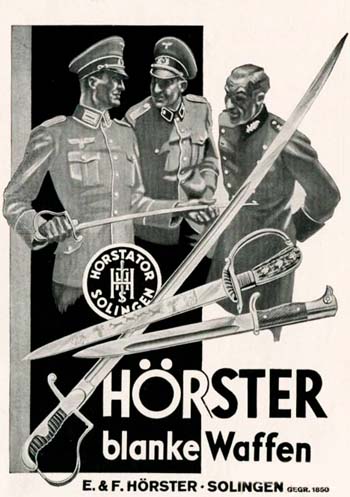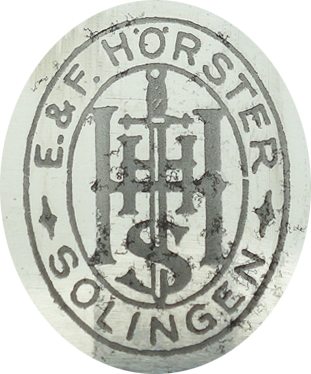E. & F. Hörster, Solingen | RZM M7/36

Hörster's beginnings trace back to 1850 when the firm began trading as "Friedrich Hörster" and later "F Hörster & Co." In 1870, on behalf of Friedrich Emil and Fritz Hörster, the Blank Waffenfabrik company changed its name to "E. & F. Hörster." It registered with the Solingen authorities on May 10, 1872. The busineß primarily focused on manufacturing: swords, sabers, bayonets and fencing foils. From the 1800s to the end of World War I, many swords/sabers and bayonets were manufactured. Their bayonets can be found with their pre-war code: "S/155" or marked "Hörster." Army/cavalry swords/sabers were also produced prior to 1918. From 1900 to 1914, Fritz Hörster was the sole owner. Fritz was later joined by his four daughters: Amalie, Hedwig, Berta and Johanne. 1920 records no longer include Fritz Hörster or Berta but show the owners as: Amalie, Hedwig and Johanne, along with Franz Hermann Hörster and Hermann August Haug. From 1928-1930, the owners were: Johanne, Franz Hermann Hörster and H. A. Haug. By 1939, H. A. Haug was the sole owner. During the Third Reich era, the company became a major supplier of edged weapons. In 1935, E. & F. Hörster was located on Katternberger Straße 128 in Solingen. That same year it was aßigned its RZM code M7/36. A July 7, 1938, letter from Hörster, lists out their vorschriftsmäßig HJ-Fahrtenmeßer pricing at 3.00 RM with increasing quantity discounts, to a firm in Austria. In January 1941, Hörster received their wartime K98 bayonet letter-codes: "asw" and "sgx" (1944). E. & F. Hörster manufactured many HJ knives, as well as being one of three Textbook manufacturers to offer 1. Model HJ knives and one of two firms of the Hitler Youth Leader dagger. Hörster most likely had the manufacturing capacity to complete full daggers on their own, where many companies needed to subcontract components. After the end of WWII, Hans-Joachim Haug, son of Hermann August, had succeeded his father. "E. u. F. Hörster GmbH & Co. Priäzisionwerk" continued to make ceremonial swords for export, in addition to: daggers, cutlery, and nail and hair clippers. Hans-Joachim Haug also acquired: Ernst Pack & Söhne, Robert Hermes, and Gottfried Weyersberg Söhne. In November 1981, "Gesellschaft für Metallverarbeitung mbH & Co." (GMS) who previously purchased Carl Eickhorn's aßets went under and much of their stock, patterns and trademarks were purchased by Hörster from liquidators. However, they were eventually sold back to "A. Eickhorn GmbH" for use on their bayonets and combat knives. Hörster continued to make swords, hunting and woodsmen hirschfängers and the naval officer's daggers. Eickhorn bought back their remaining trademark rights, when E. & F. Hörster was declared insolvent in November of 1996.
| Maker | E. & F. Hörster |
| Location | Solingen |
| RZM Number | RZM M7/36 |
| Trademark | |
| Founded | 1850 |
Looking to sell your dagger or sword? We are always buying. Please, Contact us we would be happy to assist you.

Reference:
Hogle, N. (2021). The Collector’s Guide to Hitler Youth Knives.



